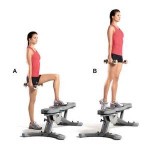Get Strong with Step Ups!
Build strong legs with this challenging exercise. Hold a weight in each hand. Stand facing a stable bench or secure chair. Step up on the bench with your right leg only. Transfer your body up onto the bench. Slowly lower your body back to the floor leading with your left leg. Return to your starting position with both feet flat on the floor to complete one rep. Next, step up with your left leg, then slowly lower leading with your right leg. Begin with ten reps total.
A few form pointers:
Maintain proper spinal alignment with your shoulders down and back.
Maintain core stability holding your belly button in.
Control is key. Slowly lift your body, pause, slowly lower your body, pause. No bounce. No swing.
Exhale when you lift. Inhale when you lower.
*Consult your physician before beginning exercise.
 Subscribe
Subscribe
